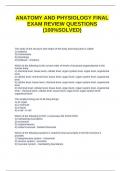ANATOMY AND PHYSIOLOGY FINAL
EXAM REVIEW QUESTIONS
(100%SOLVED)
The study of the structure and shape of the body and body parts is called:
1) anatomy
2) homeostasis
3) physiology
4) feedback - Anatomy
Which of the following is the correct order of levels of structural organizational in the
human body:
1) chemical level, tissue level, cellular level, organ system level, organ level, organismal
level
2) cellular level, chemical level, tissue level, organ level, organ system level, organismal
level
3) cellular level, tissue level, chemical level, organ level, organ system level, organismal
level
4) chemical level, cellular level, tissue level, organ level, organ system level, organismal
level - chemical level, cellular level, tissue level, organ level, organ system level,
organismal level
The smallest living unit of all living things:
1) an organ
2) a molecule
3) a tissue
4) a cell - A cell
Which of the following is NOT a necessary life FUNCTION:
1) maintaining boundaries
2) movement
3) responsiveness
4) nutrient removal - Nutrient Removal
Which of the following systems is matched most accurately to the life functions it
provides
1) integumentary system - movement
2) nervous system - excretion
3) muscular system - maintaining boundaries
,4) nervous system - responsiveness - Nervous System - Responsiveness
The survival need that is require in order to release energy from food in the
mitochondria of our cells is:
1) water
2) atmospheric pressure
3) oxygen
4) constant body temperature - Oxygen
In proper anatomical position:
1) the body is erect, feet parallel, and arms hanging at the sides with the palms facing
backward
2) the body is erect, feet parallel, arms hanging at sides with palms facing forward
3) body face up, feet parallel, arms at sides with palms facing backwards
4) body face down, feet not parallel, arms at sides with palms facing forward - the body
is erect, feet parallel, and arms hanging at the sides with the palms facing backward
Which of the following orientation and directional terms have the SAME meanings (in
humans)?
1) posterior and superficial
2) posterior and ventral
3) anterior and inferior
4) anterior and ventral - anterior and ventral
Which of the following orientation terms have opposite meanings (in humans)?
1) superficial and proximal
2) superficial and deep
3) lateral and distal
4) proximal and deep - superficial and deep
Which of the following is an anterior body landmark?
1) scapular region
2) gluteal region
3) vertebral region
4) thoracic region - Thoracic Region
Which of the following is a dorsal body landmark?
1) scapular region
2) sternal region
3) thoracic region
4) patellar region - Scapular Region
The region that contains the navel is the:
1) carpal region
2) umbilical region
3) thoracic region
,4) patellar region - Umbilical Region
A section that divides the body on the longitudinal plane into left and right parts is:
1) sagittal
2) frontal
3) transverse
4) oblique - Sagittal
Which type of section could be used to separate the thoracic cavity from the
abdominopelvic?
1) coronal
2) dorsal
3) ventral
4) transverse - Transverse
Which of the following is the correct sequence, going from superior to inferior on the
human body?
1) nasal, abdominal, patella, thoracic
2) thoracic, abdominal, nasal, patella
3) patella, abdominal, thoracic, nasal
4) nasal, thoracic, abdominal, patella - nasal, thoracic, abdominal, patella
Which of the following is an example of a physical change?
1) ice melting to water
2) digestion of food
3) fermenting grapes to make wine
4) reaction of acid with a base to form salt and water - ice melting to water
Energy that is directly involved in moving matter is termed:
1) radiant
2) electrical
3) mechanical
4) chemical - mechanical
Energy that results from breaking down and the digestion of food molecules is termed:
1) radiant
2) electrical
3) mechanical
4) chemical - chemical
Ninety-six percent of the human body is composed of the elements:
1) carbon, calcium, sodium, and oxygen
2) carbon, oxygen, iron, and potassium
3) carbon, oxygen, hydrogen, and nitrogen
4) carbon, calcium, hydrogen, and oxygen - carbon, oxygen, hydrogen, and nitrogen
, The most abundant element in the human body (and all organic things) is
1) carbon
2) oxygen
3) hydrogen
4) nitrogen - Carbon
Which subatomic particle(s) is/are found in the nucleus of an atom?
1) neutrons and protons
2) protons and electrons
3) only neutrons
4) only electrons - Neutrons and Protons
The atomic number of an atom reveals the number of:
1) neutrons
2) protons and neutrons
3) protons and electrons
4) electrons only - Protons and Electrons
An atom has 7 protons, 8 neutrons, and 7 electrons. The number of electrons in its
valence shell is:
1) 1
2) 2
3) 5
4) 7 - 5
The subatomic particles that are responsible for the chemical behavior of atoms are the:
1) protons
2) neutrons
3) electrons
4) ions - Electrons
When sodium reacts with chlorine:
1) sodium accepts an electron from chlorine and becomes a positively charged ion
2) sodium donates an electron to chlorine and becomes a negatively charged ion
3) sodium donates an electron to chlorine an becomes a positively charged ion
4) sodium becomes a neutral atom - sodium donates an electron to chlorine an
becomes a positively charged ion
When a pair of electrons is shared equally between two atoms, the bond is called:
1) ionic
2) carbon
3) polar covalent
4) non-polar covalent - Non-polar covalent
Which of the following is a compound?
1) Hydrogen gas (H2)





